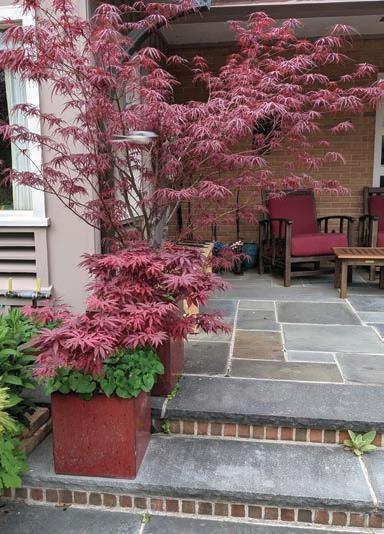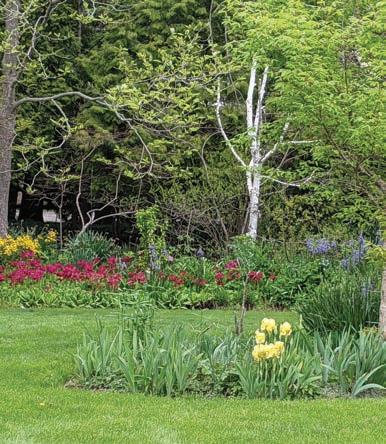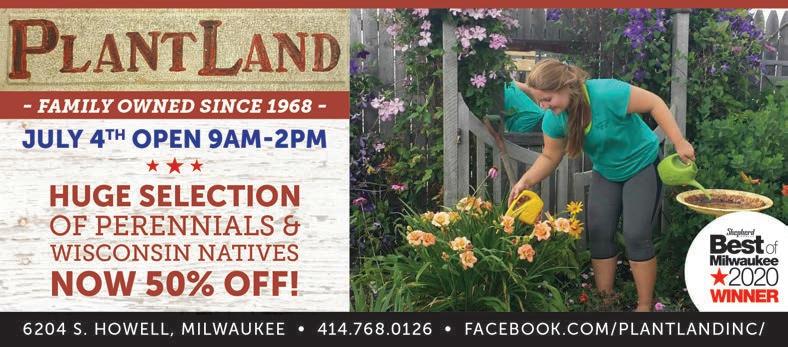
5 minute read
Planting Gardens with a Conscience


Planting Gardens wiłh a Conscience
OFF THE CUFF WITH “PLANT-A-HOLIC” MARGARETE HARVEY
BY VIRGINIA SMALL
Margarete and David Harvey’s garden will be one of four gardens open for self-guided tours during The Garden Conservancy's Open Days program, 10 a.m. to 4 p.m., August 28 and 29. Milwaukee Art Museum Garden Club volunteers are helping to coordinate and staff the tours.
A retired landscape architect, Harvey has gardened for 27 years on 5.5 acres in Bayside. She is equally enthusiastic about public gardens and encouraging opportunities for young people to learn about plants and ecology.
HOW HAVE YOU APPROACHED YOUR GARDEN'S DESIGN?
The only overall plan was to follow ecologist and author Aldo Leopold’s motto: “The oldest task in human history is to live on a piece of land without spoiling it.” We live on an exceptional piece of land with level ground above a wooded bluff leading to a large “meadow” overlooking Lake Michigan. So, I am greatly concerned about our environment and all the life forms supported by our little spot on Earth. I understand the “eco-anxiety” many children feel today as I observe events right outside my kitchen window, such as decreases in birds and insects. Or when I see clear-cutting of trees, which invites invasive species to take over, or practices that harm Lake Michigan.
WHAT ARE SOME SUSTAINABLE GARDENING PRACTICES YOU USE?
All rainwater that falls on our property stays here, through collection and infiltration. We compost all leaves and brush or otherwise recycle it on site. We bring in lots of cow manure and compost every year to keep building healthy soil. We use chemicals minimally and only on hardscaped areas.
I also focus on attracting and protecting native wildlife, for maximum plant and habitat diversity. We have a frog pond, bat boxes, bird feeders and houses, plants for pollinators and butterflies, insect boxes, and a brush pile for habitat. In summer, I raise Monarch butterflies from eggs found in the prairie.
WHAT WILL VISITORS SEE IN YOUR GARDEN?
My ornamental garden has evolved on the level ground surrounding our midcentury modern home designed by Fitzhugh Scott. Apart from one somewhat formal space (with an Oval Garden and two waterlily fishponds), I have carved out island beds wherever a tree had succumbed to age, lightning or disease. The lawn shrinks every year and is “full of weeds,” because dandelions, creeping Charlie and clover produce valuable nectar for insects.
I am a “plant-a-holic,” so there are plant collections in pots, such as tropicals, orchids and succulents. Most unusual perennials and woody plants will be labeled.
We've mostly kept the wooded bluff intact and reintroduced many native plants. This is my place for “forest bathing,” where I listen to the birds. We added two stone staircases totaling 143 steps—my daily workout.
The “meadow,” part of the ancient Nipissing Terrace, was overrun by invasive plants and needed the most attention. I've created prairie beds there, replaced many black locusts with various native trees, and installed woodland walks to observe understory plants. I also experiment with no-mow grasses and we have a rustic gathering place overlooking the lake.
WHAT INSPIRED YOU TO HELP LAUNCH LANDSCAPE-RELATED COMMUNITY EFFORTS HERE?
My father and great-grandfather were mayors of their respective tiny communities in northern Germany, so maybe it's hereditary. I also had gotten involved in volunteer
JULY 2021 | 17
MARGARETE HARVEY

efforts in our community in rural England when our daughters were young.
As a mature student in UW-Madison's landscape architecture program, I studied Milwaukee County’s park system, which had been outstanding but was gradually being underfunded. I joined the Park People: Friends of Milwaukee County Parks. I became convinced that we need more open spaces in Milwaukee’s central city, and access to the lakefront for everyone. I threw myself into the Park People’s mission—to help start park friends groups and to combat invasive weeds—such as garlic mustard, buckthorn and honeysuckle—in natural areas. With Dr. Ken Solis, I initiated the Park People's “Weed-out” program, starting with four parks. It’s still ongoing and now includes many parks! I worked to prevent the filling in of Humboldt Park’s water lily pond and to restore the memorial to Dr. Joseph Schneider, who had donated the land for Doctors Park. With Else Ankel, I started the Riverside Nature Center, which became the Urban Ecology Center. When we celebrated Lake Park’s 100th anniversary in 1994, I was part of the group that founded Lake Park Friends.
WHAT MOTIVATES YOU TO WORK TO PROMOTE WISE STEWARDSHIP OF LANDSCAPE LEGACIES?
I just want to leave this world a better place. As landscape architects, with our knowledge of the natural world and understanding of human needs, we can help build awareness about the value of designed gardens such as Villa Terrace and Dan Kiley’s now-demised horse chestnut grove.
For my graduate thesis I studied children’s attitudes toward the environment, based on their schools’ varying degrees of greenery in their play areas. I was appalled at the sterile play areas in many Milwaukee school yards, which consisted only of concrete, some turfgrass and high chain-link fences.
WHAT ROLES DO YOU THINK PUBLIC LANDSCAPES PLAY?
Public landscapes provide enormous community benefits, including fostering mental and physical health, appreciation of the natural world, and perhaps inspiring people to preserve our environment. They also can be an antidote to the grave societal disparities. Public landscapes are not valued enough. There are too many efforts to build this or that in a park, or to grab a bit of parkland here and there for other uses.
FOR MORE INFORMATION VISIT GARDENCONSERVANCY.ORG. THE GARDENS WILL BE OPEN RAIN OR SHINE AUGUST 28-29, 10 A.M. TO 4 P.M.
Virginia Small is an award-winning journalist and lifelong writer. She has served as a senior editor for Fine Gardening magazine, was a staff reporter and cultural reviewer for several newspapers, and a contributor to many national and regional publications.
Photography by Virginia Small.












